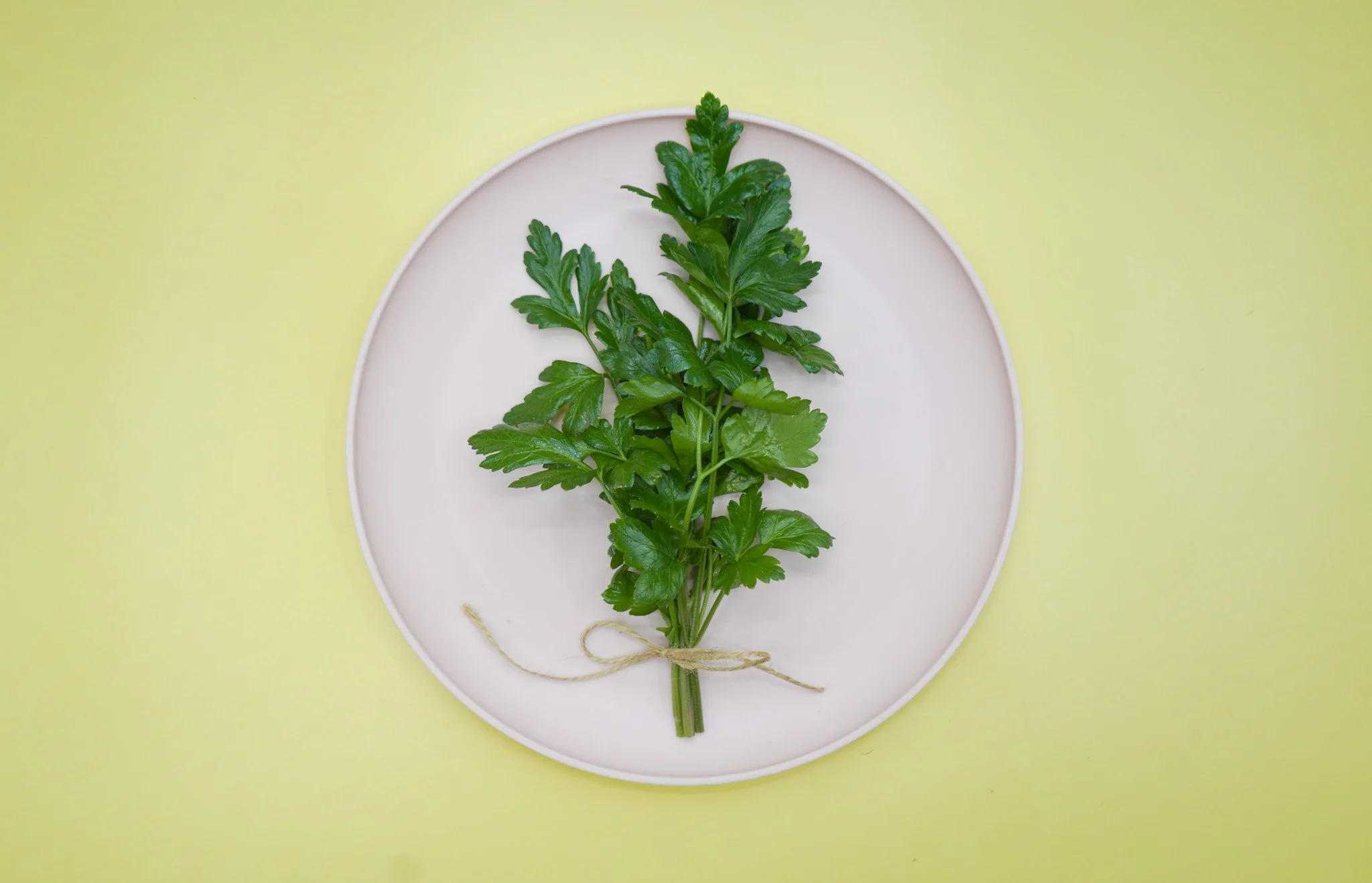Parsley
When your meal is in need of something clean and fresh, parsley always does the job. It has endless uses in the kitchen, as well as some incredible nutritional benefits. From brightening up salads to enhancing sauces, parsley proves that small leaves can make a big impact.
What is Parsley?
Parsley is a leafy herb with a bright, fresh flavor. The plant belongs to the Apiaceae family, which also includes carrots and celery. Native to the central Mediterranean region, parsley thrives in moist, well-drained soil and can grow in full sun to partial shade.
The plant has bright green, feathery leaves that come in two main varieties: curly-leaf and flat-leaf (Italian) parsley, with the latter known for its stronger flavor. At our organic farm in Arlington, VA, we grow both varieties of parsley in our nutrient-rich soil.
Wash & Store
Rinse parsley gently under cold water to remove soil or grit.
Pat dry with paper towels or spin in a salad spinner.
Wrap in a slightly damp paper towel and store in a bag or container in the fridge.
For longer storage, you can trim the stems and stand them in a glass of water (like cut flowers).
How to Prepare Parsley
Parsley’s fresh taste can transform simple dishes into something special. And while most people use only the leaves, parsley stems hold flavor and nutrition so don’t be afraid to chop the stems and add them to any recipes. Here are some ways to use parsley.
Chimichurri sauce: Combine parsley, cilantro, garlic, olive oil, red wine vinegar, oregano, and red pepper flakes in a food processor and pulse until well combined; it tastes great with grilled steak, chicken, or vegetables.
Parsley pesto: In a food processor, combine parsley, pine nuts, parmesan cheese, olive oil, and garlic and pulse until well combined.
Tabbouleh: Combine bulgur wheat, parsley, mint, tomatoes, and red onion for the salad portion. Mix lemon juice, olive oil, salt, and pepper for a dressing.
Here's a simple and fresh Parsley Dressing recipe that works well on salads, roasted vegetables, or as a marinade:
Ingredients:
1 cup fresh parsley leaves (packed)
2 cloves garlic, minced
1/4 cup lemon juice (freshly squeezed)
1/2 cup extra-virgin olive oil
1 tablespoon Dijon mustard
1 teaspoon honey (optional, for a touch of sweetness)
Salt and black pepper to taste
Instructions:
Prepare the Parsley: Finely chop the parsley leaves (you can chop the stems as well, or save them for later) or add them to a food processor or blender.
Combine Ingredients: If preparing by hand, add the minced garlic, lemon juice, Dijon mustard, and honey (if using) to a bowl with the parsley. Or add all ingredients to the food processor or blender.
Blend and Stream Oil: While blending or whisking by hand, slowly pour in the olive oil to emulsify the dressing.
Season: Add salt and black pepper to taste and blend or whisk again until smooth.
Serve: Pour over salads or use as a marinade for meats or vegetables.
Tip: For extra flavor, add a pinch of red pepper flakes or a bit of grated Parmesan cheese. Store leftovers in an airtight container in the refrigerator for up to a week.
Parsley Health Benefits
Parsley is a nutrient-dense herb with many health benefits, including digestion and kidney support, as well as offering anti-inflammatory properties.
Here are some of the main health benefits of parsley:
It’s high in antioxidants: Parsley is a good source of antioxidants, including flavonoids, carotenoids, and vitamin C. Antioxidants help protect the body from cellular damage caused by free radicals, which can lead to chronic diseases.
It’s rich in nutrients: Parsley is rich in several essential vitamins and minerals, including vitamins A, C, and K, folate, iron, and potassium.
It supports digestion: Parsley has been used in traditional medicine to support digestion and alleviate bloating and gas.
It supports kidney health: Parsley has diuretic properties, which can help increase urine production and support kidney function.
It has anti-inflammatory properties: Parsley contains compounds that have anti-inflammatory properties, which may help reduce inflammation in the body and lower the risk of chronic diseases.
Parsley Facts
Parsley is one of the most commonly used herbs in the world and is often used as a garnish for dishes such as soups, stews, and salads.
The ancient Greeks and Romans used parsley for medicinal purposes, such as reducing inflammation, freshening breath, and treating digestive issues.
Parsley is a biennial plant, which means it completes its life cycle in two years. In the first year, parsley grows a rosette of leaves, and in the second year, it produces flowers and seeds.
Area 2 Farms for Locals
Your food should be equally accessible and nutritious. Which is where we come in. At Area 2 Farms, we grow fresh organic produce within 10 miles of you.




